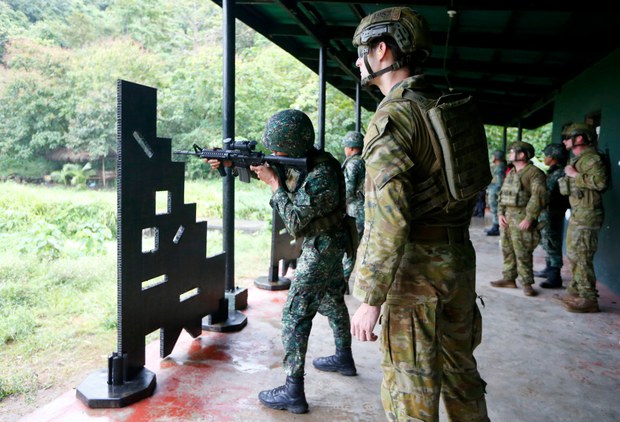Philippines, Australia Begin Joint Anti-Terror Naval Drills
2018.09.26
Davao, Philippines
 Members of the Australian Defense Forces watch Philippine Marines firing at their targets during a joint military training focused on urban terrain in Cavite province, southwest of Manila, Dec. 18, 2017.
Members of the Australian Defense Forces watch Philippine Marines firing at their targets during a joint military training focused on urban terrain in Cavite province, southwest of Manila, Dec. 18, 2017.
The Philippine and Australian navies have started 10 days of joint exercises in waters known as key sea corridors used by terror groups off the southern city of Zamboanga, officials said Wednesday, in a sign of tighter security relations amid a spate of recent bombings blamed on Islamic State-linked extremists.
Regional navy chief Rear Adm. Rene Medina told reporters the military drills with the Royal Australian Navy began Tuesday and would include patrols in the waters off Zamboanga and the island provinces of Basilan, Sulu and Tawi-Tawi.
The three islands are known to be hotbeds of the Abu Sayyaf, a small IS-linked group notorious for beheading some of its hostages.
“These continuous engagement with other regional navies are part of the anti-piracy and anti-terrorism campaign of the government, which helps curb the security threats that are affecting the islands of Mindanao,” Medina said.
“It is also a sign that both countries share a strong relationship in matters of security through this activity,” he said.
In July, military officials said the Abu Sayyaf exploded a bomb rigged to van at a military checkpoint on the southern Philippine island of Basilan, killing 11 people. Eighteen Abu Sayyaf members had been charged for the bombing, including Furuji Indama, the known leader of a faction operating on the island.
Military officials said Indama was the top lieutenant of Isnilon Hapilon, an Abu Sayyaf commander who later emerged as the local IS leader. Hapilon led a siege last year of the southern city of Marawi, where he was killed in October.
The Australian and United States governments had provided military assistance during the Marawi battle, deploying drones to help in data and intelligence gathering. Five months of vicious fighting killed 1,200 people, most of them militants, and increased concerns over regional security threats.
The Australian ship HMAS Launceston had arrived in Zamboanga for the joint drills, and would play a major role in the patrol exercises. It would be joined by the Philippine Navy’s BRP-General Mariano Alvarez in the exercise mission that would run until Oct. 4, officials said.
Medina said the drills would provide Philippine security forces with additional knowledge in “thwarting terror attacks, including abduction, in key areas of Mindanao.” It was not immediately clear how many service members would be involved in the exercises.
Capt. John Cowan, head of the Australian contingent, told reporters the battle against terrorism is “a common fight between the two countries, which shared regional maritime security concerns.”
The Abu Sayyaf, as well as local pirates, operate in waters of Zamboanga, Basilan and Sulu, where they are known to traditionally hide their captives taken during cross-border kidnapping raids, according to military officials.
The last incident was the abduction of German yachtsman Jurgen Kantner in November 2016. Kantner was beheaded months later by his captors, believed to be a faction of the Abu Sayyaf.
Two Canadian hostages had suffered the same fate the previous year after their families failed to give in to the kidnappers’ ransom demands.
Jeoffrey Maitem from Cotabato City contributed to this report.







